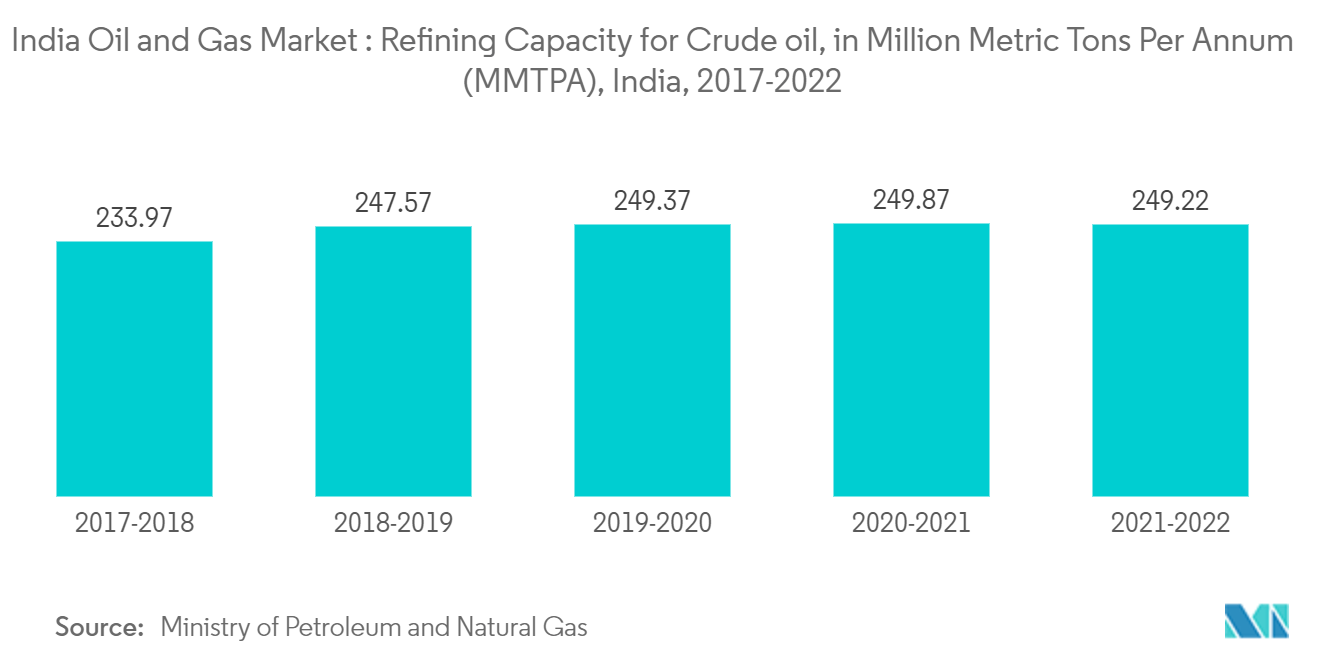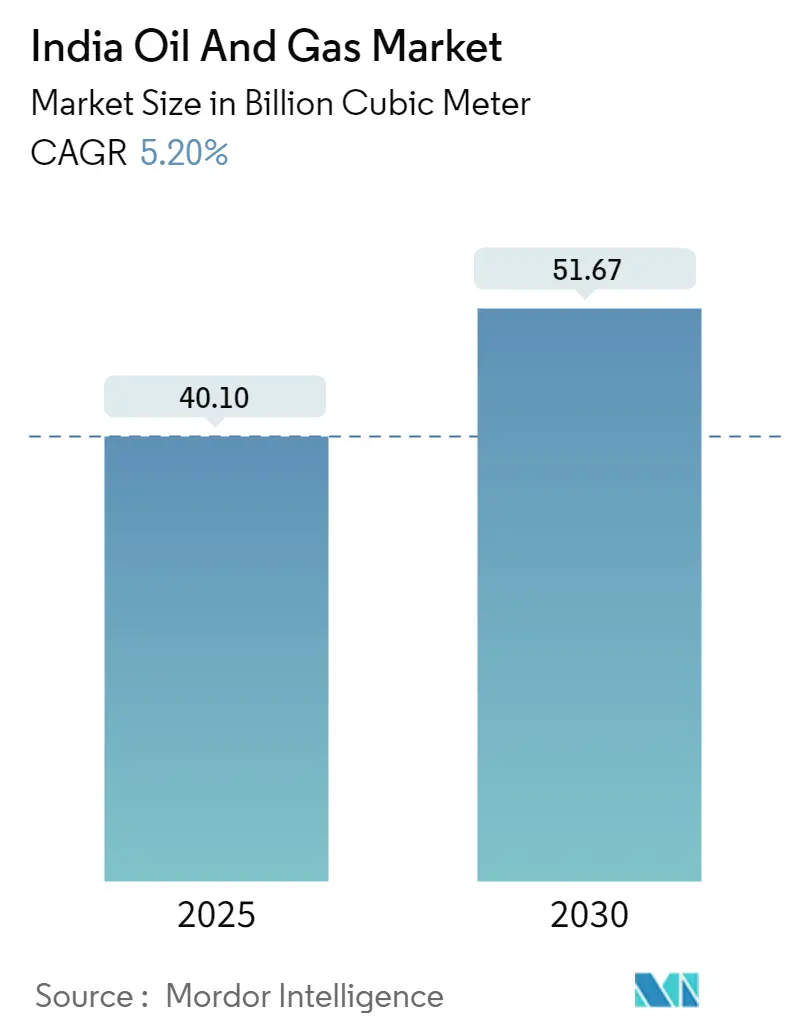
| Study Period | 2020 - 2030 |
| Base Year For Estimation | 2024 |
| Forecast Data Period | 2025 - 2030 |
| Market Volume (2025) | 40.10 Billion cubic meter |
| Market Volume (2030) | 51.67 Billion cubic meter |
| CAGR | 5.20 % |
| Market Concentration | Low |
Major Players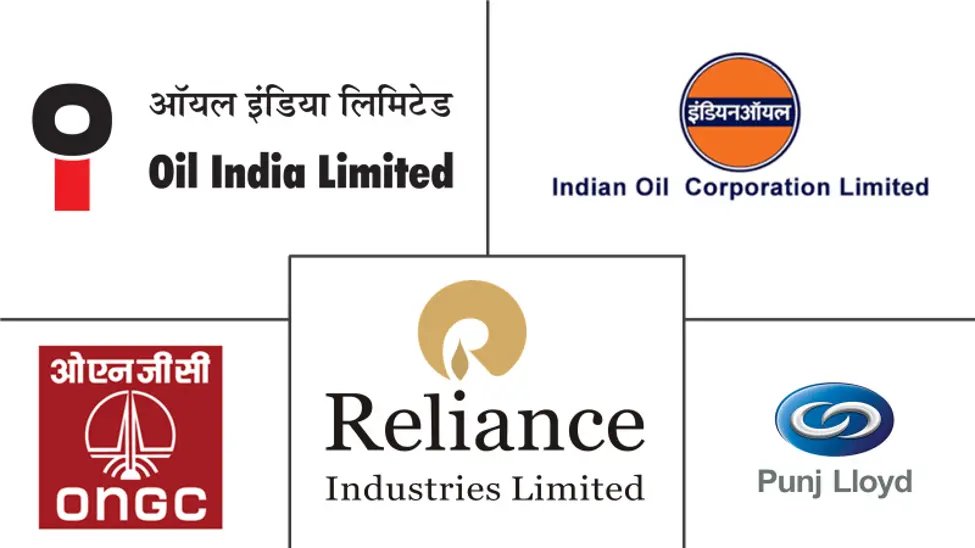
*Disclaimer: Major Players sorted in no particular order |
India Oil and Gas Market Analysis
The India Oil And Gas Market size is estimated at 40.10 billion cubic meter in 2025, and is expected to reach 51.67 billion cubic meter by 2030, at a CAGR of 5.2% during the forecast period (2025-2030).
The market was negatively impacted by the outbreak of COVID-19 due to regional lockdowns and a decline in demand for refined petroleum products. Currently, the market has rebounded to pre-pandemic levels.
- Factors such as the increasing natural gas pipeline capacity and the increasing demand for petroleum products are expected to drive the Indian oil and gas market during the forecast period. Also, the oil and natural gas market is a major industry in the energy market and plays an influential role in the global economy as the world's primary fuel source. The processes and systems involved in producing and distributing oil and gas are highly complex, capital-intensive, and require state-of-the-art technology.
- However, a huge dependence on imports of crude oil and natural gas to satisfy domestic demand and the high volatility of crude oil prices are expected to hinder the growth of the Indian oil and gas market.
- There have been significant gas hydrate discoveries in the KG Basin. Economically feasible extraction of the gas hydrates may create immense opportunities for the companies, which may lead to a boom in natural gas production.
India Oil and Gas Market Trends
The Downstream Sector is Expected to Witness Significant Growth
- Indian energy demand is anticipated to grow by 50% in the next two decades. This growth in demand can be attributed to the growing world population and an improvement in living standards in developing countries. Even though new and renewable energy sources are gaining popularity around the world, petroleum fuel remains a major energy source globally. This trend is expected to continue for the next few decades and favors the growth of the oil and gas downstream market.
- New refineries were set to be established in various parts of the country. For instance, in February 2023, Hindustan Petroleum Corp (HPCL) announced that the company plans to start its 9 million tonne-a-year Barmer refinery and petrochemical project in Rajasthan state by January 2024.
- The country's oil refinery throughput in the fiscal year (2021-2022) was 249.22 million metric tons, a growth from the 2017 figures, which were around 233.97 million metric tons. The increased value is the conclusion of the high demand for transport fuels like motor gasoline and diesel and the constantly high demand for LPG in the market's residential segment.
- The other major factor that has led to the requirement of high refining capacity is the increasing number of fields in the country, especially in the Krishna-Godavari Basin and Barmer Region of Rajasthan State. The high natural gas production from these fields has led to an expansion in the capacity of refineries and petrochemical complexes in the country.
- Owing to several major upcoming projects, the downstream sector is expected to witness significant growth during the forecast period.
Increasing Investment in the Midstream Sector May Drive the Market
- The pipeline is the most economical way of transporting natural gas, crude oil, and petroleum products over a long distance due to increasing investments in upcoming pipelines in the country. The midstream segment is expected to contribute a decent share in the Indian oil and gas market in the coming years.
- As of March 2022, the country had around 10,419 km of crude oil pipelines (onshore: 9,825 km and offshore: 594 km), 17,389 km of natural gas pipelines (onshore: 17,365 km and offshore: 24 km), and 14,729 km of refined products pipelines, being operated by IOCL, BORL, Cairn India, OIL, HMEL, and ONGC. In addition to the pipelines, India had 5 LNG terminals in March 2022.
- In February 2022, the government of India announced to double its exploration area of oil and gas to 0.5 million sq. km. by 2025 and to 1 million sq. km. by 2030 with a view to increasing domestic output.
- As of June 30, 2022, the Gas Authority of India Ltd (GAIL) had the largest share of the country's natural gas pipeline network, i.e., 33,815 km.
- As of 2022, Indian Oil Corporation accounted for 50.88% (15113 km) of India's crude pipeline network. The Indian government is set to invest USD 9.97 billion to expand the gas pipeline network across the country, culminating in the growth of the market.
- In March 2022, Indian Oil Corporation (IOC) Limited approved to invest USD 932.6 million for the development of City Gas Distribution (CGD) network in 9 geographical areas.
- Hence, increasing investments in the midstream sector have driven the India oil and gas market. Pipeline coverage is expected to increase substantially during the forecast period, with the petroleum product pipeline expected to increase the most in the segment.
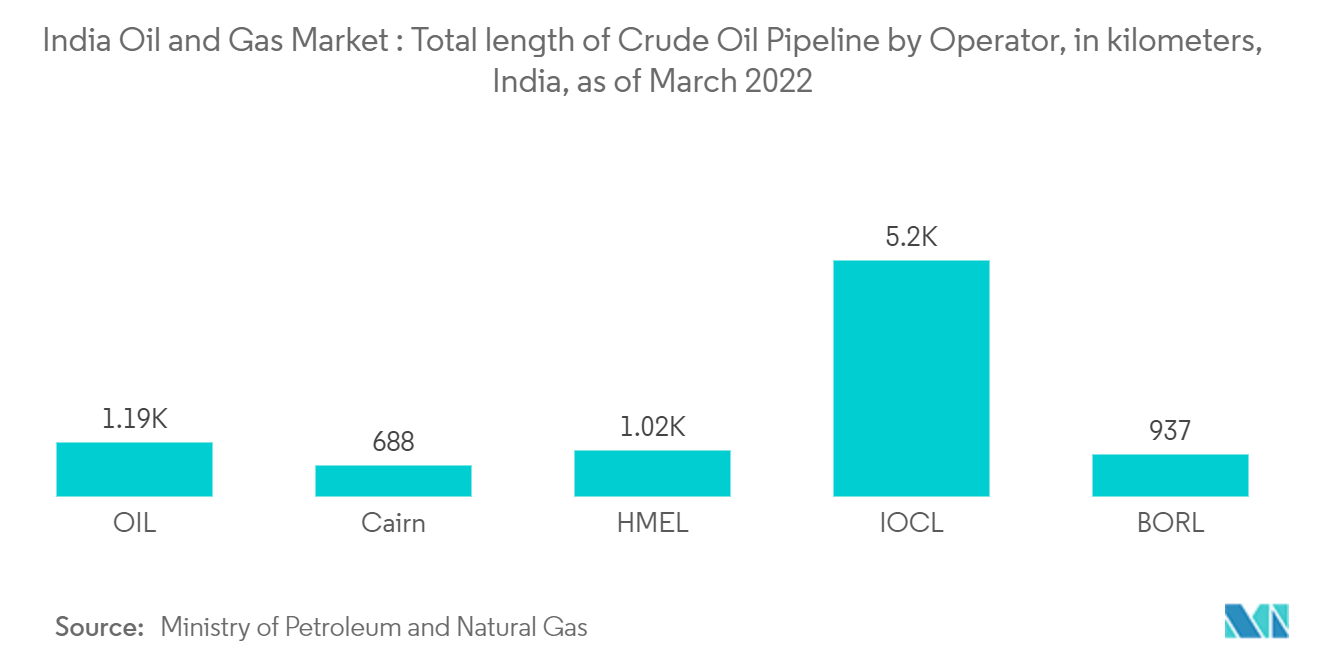
India Oil and Gas Industry Overview
The India oil and gas market is fragmanted. Some of the key players (in no particular order) include Oil and Natural Gas Corporation (ONGC), Oil India Limited (OIL), Reliance Industries, Indian Oil Corporation Limited (IOCL), and Punj Lloyd Limited., among others.
India Oil and Gas Market Leaders
-
Punj Lloyd Limited
-
Oil India Limited
-
Indian Oi Corporation Limited
-
Oil and Natural Gas Corporation
-
Reliance Industries Limited
- *Disclaimer: Major Players sorted in no particular order
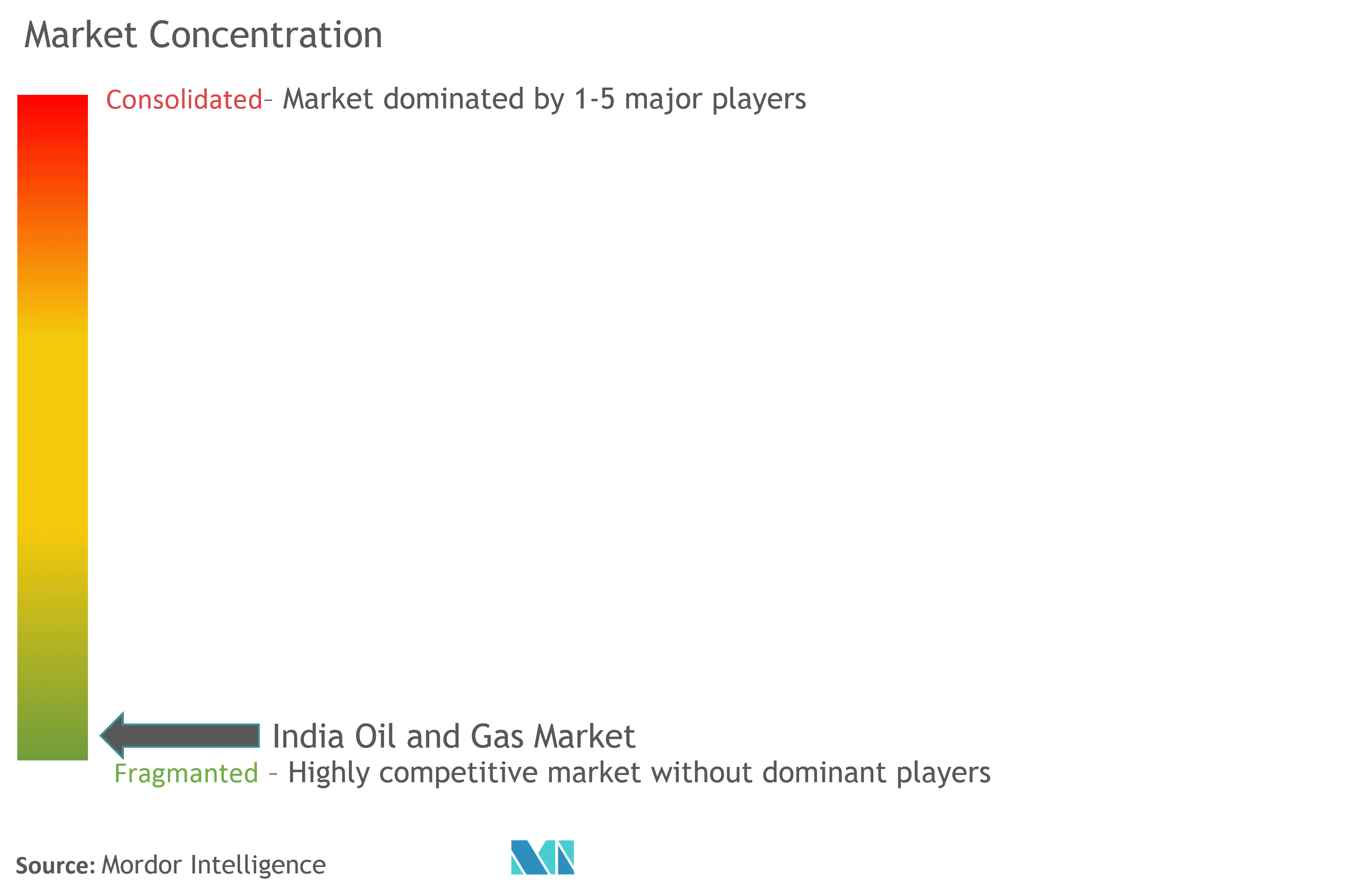
India Oil and Gas Market News
- In March 2023, Indian Oil Corporation Ltd. announced that the company would invest USD 742 million in building a petrochemical complex at Paradip in the state of Odisha.
- In January 2022, Adani Total Gas Ltd (ATGL), a joint venture between the Adani Group and TotalEnergies, won licenses to expand its City Gas Distribution (CGD) network to 14 new geographical areas with an investment of USD 243 million.
India Oil and Gas Industry Segmentation
The oil and natural gas market is a major industry in the energy market and plays an influential role in the global economy as the world's primary fuel source. The processes and systems involved in producing and distributing oil and gas are highly complex, capital-intensive, and require state-of-the-art technology. The oil and gas value chain includes extraction of petroleum, refining, transportation, and retailing.
The India oil and gas market is segmented by sector. By sector, the market is segmented into upstream, downstream, and midstream. The market sizing and forecasts have been done based on Production volume (billion cubic meters).
| Sector | Upstream | Location of Deployment | Onshore |
| Offshore | |||
| Downstream | Refineries | ||
| Petrochemical Plants | |||
| Midstream | Transportation | ||
| Storage | |||
| LNG Terminals | |||
India Oil and Gas Market Research FAQs
How big is the India Oil And Gas Market?
The India Oil And Gas Market size is expected to reach 40.10 billion cubic meter in 2025 and grow at a CAGR of 5.20% to reach 51.67 billion cubic meter by 2030.
What is the current India Oil And Gas Market size?
In 2025, the India Oil And Gas Market size is expected to reach 40.10 billion cubic meter.
Who are the key players in India Oil And Gas Market?
Punj Lloyd Limited, Oil India Limited, Indian Oi Corporation Limited, Oil and Natural Gas Corporation and Reliance Industries Limited are the major companies operating in the India Oil And Gas Market.
What years does this India Oil And Gas Market cover, and what was the market size in 2024?
In 2024, the India Oil And Gas Market size was estimated at 38.01 billion cubic meter. The report covers the India Oil And Gas Market historical market size for years: 2020, 2021, 2022, 2023 and 2024. The report also forecasts the India Oil And Gas Market size for years: 2025, 2026, 2027, 2028, 2029 and 2030.
Our Best Selling Reports
Oil and Gas in India Industry Report
The oil and gas market in India is poised for significant growth, driven by advancements in exploration, extraction, and production technologies that enhance efficiency and reduce costs. The market size of the oil and gas industry in India is segmented into upstream, midstream, and downstream sectors, each playing a crucial role in the overall value chain. Applications are divided into offshore and onshore activities, reflecting the diverse operational environments. The downstream sector is expected to witness substantial growth due to rising energy demand and the establishment of new refineries. Additionally, increasing investments in the midstream sector, particularly in pipeline infrastructure, are anticipated to drive market expansion.
The industry's evolution is influenced by economic trends, geopolitical factors, technological advancements, and environmental considerations, with a growing emphasis on sustainable practices and renewable energy sources. The competitive landscape of the oil and gas industry in India is characterized by a fragmented market with numerous key players, each contributing to the dynamic and complex ecosystem of oil and gas companies in India.
The report provides an industry overview and includes detailed market data, market forecast, and market growth analysis. It offers insights into industry trends, industry size, industry statistics, and industry outlook. The report also highlights market segmentation, market value, and market predictions, providing a comprehensive market overview and market review.
Industry reports and industry research focus on the growth rate and market leaders, offering a detailed market outlook. The report pdf serves as a valuable resource for research companies, providing an in-depth industry analysis and industry information. The industry sales and market value are thoroughly examined, ensuring a detailed understanding of the market dynamics. The report example included in the analysis offers a practical demonstration of the market's potential and future growth.



